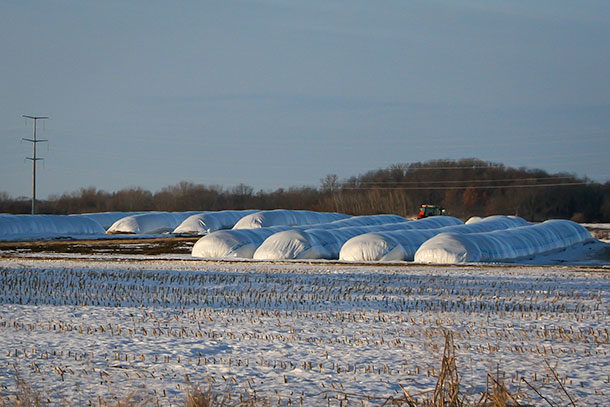No article about improving bunk life would be complete without first reiterating why it’s so important. When you harvest hay and forage crops, your goal is to capture the highest feed value possible.
When the highest-quality forage is fed, you boost animal health and performance and lower production costs. But, there are many variables that can influence forage quality. Capturing quality is not an easy task when you’re competing with Mother Nature. Considering all the effort, cost and frequent frustrations of putting up feed, bunk life matters.
Bunk life is a straightforward concept that helps us understand how long feed might last after it's placed in the bunk before quality and value are diminished by spoilage. Typically, the term refers to silage in a bunk or bale. Spoilage results from oxygen exposure and reactivation of aerobic bacteria (the bad bacteria) that decrease feed value while increasing temperatures during the initial phases of the ensilage process. Temperature is the simplest and most practical measure of spoilage. When temperatures increase above 120°F, proteins become bound to fiber, where they are unavailable to animals.
Improving bunk life by having more time for livestock to consume a greater volume of higher-value feed simply means your operation can take full advantage of your efforts. You’ll benefit from improved animal health and performance, operate with lower production costs and receive a higher return on your feed investments.
Here are six tips for increasing bunk life:
- Manage bunk, trench or bag silos. Size of the bunk or bag face matters. Once a face is opened, it's exposed to oxygen, and as a result, the temperature rises. It's important to size a bunk to ensure enough feed is removed from the entire face to ensure the whole face remains "cool." When fed, the "cool" silage will be more stable, and proteins will remain available for a longer period of time.
- When to wrap baled silage crops. When baling, it's particularly important to wrap bales as soon as possible. Wrapping the following day (24 hours later) may result in rapid reproduction of aerobic bacteria and higher bale temperatures. When wrapped bales are unsealed, and silage is exposed to oxygen, reactivation of this higher bacterial population simply means temperatures and spoilage will occur more quickly.
- Make the densest bales possible. Increasing material density means there is more hay and less oxygen trapped within the bale. When wrapped, dense bales transition more quickly from the aerobic to the fermentation phase. As a result, the reproduction of aerobic bacteria is limited, and silage pH is reduced, indicating improved forage stabilization. A recent Penn State University study found that when fed in a ring, dense silage bales extended whole-bale bunk life up to 25 hours compared to less dense bales. Simply put, this means more time is available for livestock to consume feed prior to spoilage. Feed waste may be reduced while animal intake increases.
- Consider cutting baled silage. Cutting baled silage offers producers the same whole-bale bunk life advantages. Cut bales form with smaller particle sizes, and bale densities are typically higher than in an uncut bale. This excludes still more oxygen from the ensilage process. Cut bales have additional advantages in a ring feeder. Cut bales are easy for livestock to pull apart, which increases rate of intake. And, smaller particle size typically reduces waste, driving further operational savings.
- Mixing considerations with a TMR. The use of ration mixers for livestock production has improved livestock operations. These machines process uncut bales to an ideal particle length for consumption while allowing for a uniform mix of grains and supplements. There are a number of advantages to processing a cut hay bale with a total mixed ration (TMR) mixer, including less power requirements, fast bale breakup and more consistent particle size. When a mixer processes an uncut silage bale, it takes substantially longer, which can introduce more oxygen into the ration. This may increase ration heating and hasten spoilage. By pre-cutting bales, TMR mixing time can be significantly reduced, rations can be fed more quickly and bunk time to feed before spoilage can be extended, even if only slightly.
- How much you feed absolutely matters. Several things might extend bunk life, yet the most important consideration is often the simplest. It’s a lesson many of us learned on the farm as children. My family had two simple rules for dinner. Number one: Never leave the table until you are full. Number two: Only take what you will eat. As my grandfather always said, "Waste not, want not." While these rules won’t extend bunk life, they greatly reduce spoilage and waste, which is the goal. If your livestock cannot consume a large round bale before spoilage, the waste is significant, and so is the impact on your bottom line.











